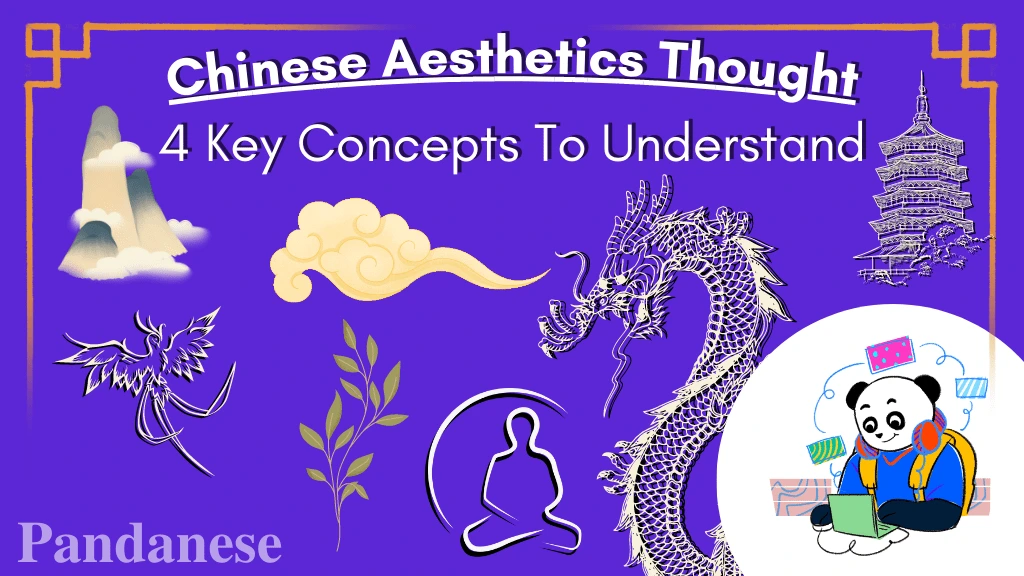
The 4 Key Concepts of Chinese Aesthetic in Chinese Art
Chinese aesthetics are a complicated and multi-faced concept that covers various topics and fascinates people worldwide. Many of China's major contemporary and traditional philosophers have influenced key Chinese aesthetic concepts.
You can learn about people's impressions of the Chinese Aesthetic in this video:
People's thoughts about Chinese aesthetic (traditional and modern), Lansei in China | 环游的LanseiThis article explores this theme by examining the key characteristics of Chinese cultural and psychological structures and the main art forms expressing these concepts.
What are the key concepts within Chinese aesthetic?
Aesthetics is a concept that has spanned within Chinese history.
When talking about "Chinese aesthetic tradition," we include everything from poetry, painting, calligraphy, architecture, literature, ceramics, bronzes, music, martial arts, and so on.
Each topic is so broad that they deserve an article on its own. Still, we will review some of the main points and some characteristic symbols of Chinese aesthetics.
1. Nature and rules
In China, aesthetics tend to follow two seemingly contradictory notions: naturalness (ziran 自然) and regularity (fa 法).
Tang-era poetry is a perfect example of this apparent juxtaposition: indeed, these poems follow a set of rules regarding the length and number of lines, tones, and parallelisms. Yet reading the works of the greatest poets of the time, such as Du Fu 杜甫, Li Bai 李白, or Wang Wei 王維, one has a feeling of absolute naturalness, a concept rooted in Daoism, which emphasized the importance of the natural world and harmony.

Du Fu: Two Yellow Orioles A-Singing In The Green Willow Poem; Poem Hunter
Inspired by naturalist ideas of Daoism, the poetry critic Zhong Rong of the Southern Dynasties praised the "charm of spontaneity" (自然英旨) and criticized the excessive use of fixed structures and ornate language.
The inspired notions that nature evokes in Chinese artists can be seen in their depictions of the natural world. Landscape painting, in particular, communicates with nature and expresses a spiritual connection to the world around us.
This connection is reflected in the artist's techniques, such as negative space and ink wash, which seek to capture the ephemeral qualities of nature and the changing moods of the environment. Another example of Taoist influences in Chinese poetry is the concept of 悲慨 beikai (melancholy and resentment) towards the immensity of nature, reflecting the artist's stoic optimism.
2. Openness
Another important notion in Chinese aesthetics is that of openness. This concept is also due to classical Chinese syntax's syntactic indeterminacy or ambiguity.
In aesthetic terms, the idea of suggestiveness found lasting expression in the saying of the poet and critic Tang Sikong Tu 司 空 圖 (837-908) that poetry should convey "images beyond images" and "scenes beyond scenes" (xiang wai zhi xiang; jing wai zhi jing 象外之象; 景外之景).
The concept of openness can also be linked to the concept of 隐秀, latent and apparent meanings are seen as inseparable and constitute an aesthetic feature of good literary works.
3. Qi
One of the central points of Chinese aesthetics is the concept of qi, or life energy, which is believed to animate all living things. This idea is closely related to the Taoist concept of yin and yang, according to which it is crucial to find balance and harmony in all aspects of life.
In art, this means that the artist should strive to capture the essence of a subject rather than simply replicating its physical appearance. This approach is exemplified in calligraphy, which conveys the artist's energy and spirit through brush strokes.
Chinese aesthetics greatly emphasize the artist's role in creating a work of art. The concept of "qi," or the vital energy that flows through all things, is often invoked in discussions of Chinese aesthetics.
Artists are encouraged to cultivate their inner "qi" to create expressive and dynamic works, aiming to achieve spiritual transcendence. This particular type of qi is called 文气 wenqi, a concept Cao Pi proposed for the first time in his "A Discourse on Literature." It refers not only to a writer's talent but also to the linguistic manifestation of his personality. Through the pursuit of wenqi, artists can achieve a deeper connection with the divine and attain spiritual transcendence in their work.
4. Symbols
Another important aspect of Chinese aesthetics is the use of symbolism and metaphors.
Many Chinese artworks contain hidden meanings and allusions to convey deeper truths or insights about the world.
For example, the lotus flower is often used to symbolize purity and enlightenment. At the same time, the pine tree is associated with longevity and resilience. The dragon and the phoenix are other common symbols in Chinese art forms.
a) The dragon
The Chinese zodiac uses common animals except only one, the dragon. It has never been seen.
So, where does this animal come from? The dragon is a mysterious animal in Chinese mythology, capable of jumping, flying, walking, spitting wind and rain, and bringing good to all, so in the imagination of the Chinese, it possesses the characteristics of many animals:
The eyes of the shrimp
The horns of the deer
The lips of the ox
The nose of the dog
The whiskers of the catfish
The tail of the snake
The legs of the eagle
In ancient times, the dragon was considered a symbol of imperial power and royal lineage. Every emperor considered himself a "dragon" or "true dragon child of heaven," so the objects used by emperors were decorated with the figure of the dragon, while ordinary people could not use this symbol. The emperor's face was called "dragon face," his robe "dragon robe," and his descendants "dragon children" and "dragon grandchildren."

An imperial robe with the figure of the dragon (龙袍 lóng páo); Beautimode
The Han ethnic group has always considered it its symbol. Therefore, the Chinese call themselves "descendants of the dragon." Particularly talented people are compared to the dragon, e.g., "a dragon among human beings,'' so Chinese parents hope that "their children will become dragons," i.e., noble, excellent, and illustrious people.
Even today, the Chinese consider the dragon a magical animal and an auspicious symbol, so they decorate temples and gardens with its image.

Nine-Dragon Wall (九龙壁 jiǔ lóng bì); Visitbeijing
b) The phoenix
During traditional Chinese wedding ceremonies, the bride's rich and glorious attire leaves a deep impression on those who see her.
What attracts the most attention is the ornament on her head, resembling a bird with multicolored feathers, called the "feng (phoenix) crown." (In Mandarin 凤冠 fèngguān).

Ancient Chinese head ornament - 凤冠 fèngguān; Wiki Media Commons
Why does the crown have this shape? And what does feng mean? Feng, or fenghuang, is the phoenix, the king of birds in Chinese legend, with the head of the peacock, the body of the swan, and the wings of the golden rooster, considered a messenger of happiness. The ancients believed that a phoenix appeared in times of peace and prosperity, and where it stopped, rare treasures often appeared.
The phoenix can be male or female, the male is called feng and the female huang, and together they form fenghuang. However, the figure of fenghuang was often side by side with the dragon, so it gradually changed from male to female. The dragon and phoenix formed the "dragon and phoenix culture."
Therefore, the emperor was the dragon, and the empress was the phoenix. In China, many men are called Long (dragon), and many women Feng. The phoenix is also a symbol of nobility, dignity, purity, and virtue, which is why the bride's headdress is shaped like a phoenix, which is still found in many traditional clothes.
What does Chinese aesthetic look like in Chinese art?
1. Traditional Chinese painting
Chinese aesthetic tradition fills an important gap in traditional Chinese art.
Traditional Chinese painting indicates brush painting, especially with bright colors and chiaroscuro, often on silk and Xuan paper, which is then framed and rolled.
In traditional painting, the most commonly used colors are red and blue-green. It is divided into three main types: character, landscape, flower, and bird. Chinese character painting emphasizes expression, landscape painting the ideal dimension, and flower and bird painting the resemblance to the real thing.
Traditional Chinese painting is very different from Western painting; it perfectly integrates painting, poetry, and calligraphy, privileges spirit, and is based on line and ink density. It includes large blank spaces, where poems are often written, and the seal is impressed with the painter's name at the end.

Chinese painting with calligraphy, ocair
Traditional Chinese painting favors the ideal dimension, with nature as the basis, but without realism. For example, in character painting, you usually cannot recognize the identity of the portrait. Still, you can tell whether it is a servant girl, a noblewoman, or a mischievous child.
2. Chinese calligraphy
It is no exaggeration to say that the Chinese have an unbreakable bond with calligraphy.
For example, the first newborn’s photo in the family album has congratulations written with brush and ink. When getting married, the wedding trousseau is embroidered with auspicious words in calligraphic style. Then for birthdays, a picture with the character meaning longevity (寿) written in calligraphic style is attached in the house. Even after death in Chinese culture, the grave’s epitaph is has a calligraphic style written on it.

Example of a grave’s epitaph written in calligraphy style; Meipian
During major holidays mottoes and phrases written in calligraphy are displayed in homes and given to relatives; tea rooms, gardens, and even the walls and entrance gates of cities have phrases and mottoes written by more or less famous calligraphers.
Calligraphic-style characters embellish numerous things ranging from fans to restaurant menus to business cards and commercial catalogs.
The tools used for Chinese calligraphy are called "the four treasures" and are the brush, paper, ink, and ink stone. You can find many tutorials online:
Introduction to Chinese calligraphy, Calligrapher NickFrequalty asked question
Which Chinese philosophy influenced chinese asethics?
Both traditional and contemporary Chinese philosophy has influenced Chinese asethics.
Chinese thought and Chinese philosophy have had a significant influence on Chinese aesthetics. Many fundamental Chinese aesthetic concepts and principles are deeply rooted in Chinese philosophical traditions. Chinese aesthetic tradition touches on two major Chinese philosophies:
1. Confucianism
One of the most influential thinkers in China, Confucius, helped emphasizes the importance of social order and moral values, and these ideas have greatly influenced Chinese aesthetics.
Confucian ideas and concepts such as "li" demonstrates conclusively in Chinese aesthetic principles of harmony, balance, and restraint, as well as paying attention to detail and adhering to established norms and standards, which can be found in traditional Chinese art.
2. Buddhism
Buddhist ideas such as impermanence, detachment, and emptiness have influenced how Chinese artists and thinkers view the world and create art. Buddhist meditation practices, which emphasize mindfulness and awareness, have also impacted the development of Chinese aesthetics, particularly in calligraphy and ink painting.
Additionally, the ideas of Chan Buddhism and Chan Buddhist inspired notions of meditation, mindfulness, and spontaneity which relates to where artists seek to capture the essence of their subject matter.
Overall, Chinese philosophy has been the driving force behind Chinese aesthetics’ development, shaping how people view and appreciate art in China.
In closing
This article provided insights into the big theme of Chinese aesthetics influenced by the ideas of contemporary China's foremost intellectuals in Chinese philosophy. Hoped that it inspired you to learn more about Chinese culture and its symbolism.
Elisa Felici has been studying Chinese since 2014. She started her language-learning journey at Italian universities and lived in Beijing while attending Beijing’s Confucius Institute. Elisa passed HSK 4 and 5 and finally, in 2020, HSK 6. She now has a Master’s degree in translation and interpreting and has experience not only as a language learner but also as a Chinese teacher and translator.
The easiest way to learn Chinese & build vocabulary

